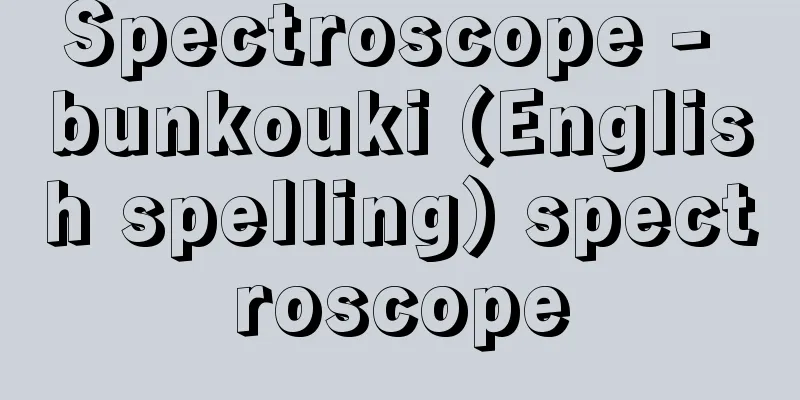Spectroscope - bunkouki (English spelling) spectroscope

|
A device for observing and measuring the spectrum of light. In the narrow sense, it breaks down electromagnetic waves according to their wavelengths and measures their intensity distribution, but in a broader sense, spectroscopes are used to refer to analytical devices that examine the energy distribution of particle beams such as electron beams, in addition to electromagnetic waves. A spectrophotometer for measuring absorption spectra consists of a light source that emits a continuous spectrum, a monochromator, an absorption sample chamber, a detector, and a recording device. Spectrophotometers can also be classified by the dispersive element that separates light waves according to their wavelengths. There are prism spectrometers that use prisms, diffraction grating spectrometers that use diffraction gratings, interference spectrometers that use interferometers, and filter spectrometers that use filters. Diffraction grating spectrometers include plane grating spectrometers and concave grating spectrometers that use concave diffraction gratings. There are also spectrometers that use a combination of prisms and diffraction gratings, which are small and provide high resolution. Filter spectrometers use narrow-band filters that transmit only certain wavelengths. Spectrometers can also be classified according to the wavelength range they can be used in. They are divided into gamma ray spectrometers (which use the height of the detector's output pulse to disperse light), X-ray spectrometers (which use a crystal lattice as a diffraction grating), vacuum ultraviolet spectrometers (the optical system is housed in a vacuum chamber), visible/ultraviolet/near-infrared spectrometers, and infrared spectrometers. Visible light spectroscopes include direct viewing spectroscopes, which allow you to observe the spectrum simply by looking through it, and wavelength spectrometers, which allow you to directly read the wavelength of light from the rotational position of the spectroscopic element. [Tatsutake Onaka and Masahide Ito] "Spectroscopic Instruments Q&A" edited by the Spectroscopic Society of Japan (2009, Kodansha) [Reference] | | | | | | |Source: Shogakukan Encyclopedia Nipponica About Encyclopedia Nipponica Information | Legend |
|
光のスペクトルを観察・測定する装置。狭義では、電磁波をその波長の違いによって分解し、その強度分布を測定するものであるが、広義には、電磁波だけでなく、電子線などの粒子線のエネルギー分布を調べる分析装置も分光器とよばれている。 吸収スペクトルを測定するための分光光度計は、連続スペクトルを放射する光源、単色装置、吸収試料槽、検知器、計算記録装置で構成されている。また、光波をその波長によって分解する分散素子による分類もある。プリズムを用いたプリズム分光器、回折格子を用いた回折格子分光器、干渉計を用いた干渉分光器、フィルターを用いたフィルター分光器がある。回折格子分光器には、平面格子分光器と凹面回折格子を用いた凹面格子分光器がある。またプリズムと回折格子を複合使用した分光器もあり、小型で高分解が得られる。フィルター分光器では、特定の波長のみを透過する狭帯域フィルターを使用する。 また、使用できる波長領域による分類もある。γ線分光器(ガンマせんぶんこうき)(検出器の出力パルスの高さで分光する)、X線分光器(回折格子として結晶格子を利用する)、真空紫外分光器(光学系が真空槽の中に収納されている)、可視・紫外・近赤外分光器、赤外線分光器などに区別される。 可視分光器には、のぞくだけでスペクトルを観察できる直視分光器、分光素子の回転位置から光の波長が直読できる波長分光計もある。 [尾中龍猛・伊藤雅英] 『日本分光学会編『分光装置Q&A』(2009・講談社)』 [参照項目] | | | | | | |出典 小学館 日本大百科全書(ニッポニカ)日本大百科全書(ニッポニカ)について 情報 | 凡例 |
>>: Wen Gong Jiā Lǐ (English: Wen Gong Jiā Lǐ)
Recommend
Ginzburg, AI (English spelling)
...The trial took place on February 16, 1967 and ...
Methylene chloride - methylene chloride
Also known as dichloromethane. Chemical formula: C...
Genoa
Genoa is the largest trading port in Italy, with ...
Yaśovarman (English spelling)
? - circa 745. King of India. Reigned from circa 7...
Intimist - Intimist (English spelling) French
In the history of painting, the term broadly refe...
Blue Sky
...The main weeds are F. miliacea (L.) Vahl (illu...
Astronomical unit - Tenmontan-i
A unit of length used in astronomy. The average d...
English education - English education
In documents from the Meiji and Taisho periods, t...
Arcadia
…therefore, they played no prominent role in Gree...
Girsu
…A city in the southernmost part of Mesopotamia, ...
Hanahirinoki - Hanahirinoki
A deciduous shrub of the Ericaceae family (APG cl...
Camellia (Camellia) - Camellia
An evergreen tall tree of the Theaceae family foun...
Chord name (English spelling)
It is an abbreviated notation for chords that orig...
Satsunan Islands
The term "Satsuma-Nansho" refers to the...
The Former Nine Years' War
In the late Heian period, Minamoto no Yoriyoshi an...









